During a long-term power outage, you’ll need a way to cook food without electricity.
There are a lot of options, from the high-tech to the downright primitive.
What’s important is that you prepare your emergency stove before a power outage occurs, so you aren’t left hungry and staring at your bags of pasta, rice, and beans but without any way to cook them.
Read more about preparing for a power outage.
Notes:
- Because some methods of cooking without electricity can only be done safely outdoors, this article is divided into two parts: Cooking without power indoors and cooking without power.
- If you run out of fuel, it is wise to have multiple ways to cook during a power outage. For example, a propane camping stove that can be used indoors and a small wood stove that you can use outdoors if you run out of propane.
Ways to Cook without Power Indoors
Warning: Some of these indoor cooking methods burn fuel. Anytime you burn fuel indoors, there is a risk of carbon monoxide poisoning. Make sure you have adequate ventilation (even in winter). Also, be sure to have a carbon monoxide detector and fire extinguisher nearby.
Read more about CO poisoning during power outages. And see our picks for Best Indoor Emergency Stoves.
1. Gas Camping Stove
Gas camping stoves run on canisters of butane, propane, or isobutene. Some can even use multiple types of fuel, like unleaded gasoline, in a pinch.
For long-term preparedness, you’ll want a camping stove that connects to large propane tanks. You’ll blow through small canisters quickly if you need to cook things like dry beans or boil drinking water.
Recommended: Coleman Portable Stove
2. Alcohol Stove
Alcohol is a great fuel for stoves because it burns very cleanly. Unfortunately, cooking with alcohol can be a bit tricky because it is hard to control the heat. Once they get the hang of it, though, many people prefer alcohol stoves over gas stoves.
Which alcohol can you use in an alcohol stove?
Denatured alcohol, pure methanol alcohol, pure ethanol, and alcohol (Everclear) all work.
You can even use some fuel-line antifreeze (such as the HEET brand in a yellow bottle) as it is made from pure methanol alcohol. Rubbing alcohol (isopropanol) works but doesn’t burn cleanly, so only use that one outdoors.
Recommended: Lixada Alcohol Burner
3. Canned Heat
Also known as Sterno or gelled fuel, canned heat is made from alcohol turned into a jelly. Like an alcohol stove, it is hard to control the flame and heat.
I prefer alcohol stoves over canned heat because it is cheaper and has other uses. However, canned heat won’t evaporate as alcohol will, so it is easier to store long-term.
Recommended: Liquid Safety Cooking Pack
4. Tuna Can + Toilet Paper Stove
This one I learned while hiking with a former Israeli Special Forces soldier. Apparently, the Israeli army gets fed a lot of canned tuna. The “stove” also serves as a great emergency light source and emergency heat source.
Here is how it works.
- Open a can of tuna in oil. It would work with something else oily too.
- Take 3 pieces of toilet paper and place them flat over the tuna. They will absorb the oil. The toilet paper should create an air-tight seal around the lid of the can.
- Set the toilet paper on fire.
- It will burn for a LONG time (up to 25 minutes)!
- Use the flame for cooking food.
- The flame will also cook the tuna inside the can. Just remove the toilet paper and enjoy your hot tuna.
You’ll need a pot stand since putting the pot directly on the can will extinguish the flame. This one on Amazon is cheap and can also be used with alcohol stoves, wood, or esbit.
5. Buddy Burner
A buddy burner is similar to the tuna can stove above. To make one:
- Get an empty tuna can
- Cut cardboard into strips that are slightly thinner than the height of the tuna can. You should cut across the corrugated part so the holes are exposed on the sides.
- Roll up strips of cardboard tightly and fit them inside the tuna can.
- Using a double boiler, melt wax. You can use old crayons or candles for the wax. I’ve also heard of people using butter instead of wax. Never try to melt wax over a direct flame because it easily catches fire.
- Pour the melted wax over the cardboard. Fill the holes in the cardboard but leave a bit of the cardboard roll exposed to serve as the wick.
- Once the wax hardens, you can light the buddy burner. You can stick a small piece of cardboard inside to serve as a wick and make lighting it easier if your wish.
6. Hay Box Oven
A hay box oven is a box that traps heat. To use one, you first have to heat your pot of food (which can be done outdoors on a fire).
Then you put it in the hay box oven, surround the pot with hay, close the box, and wait 8-12 hours for the food to be done.
The hay box traps thermal heat, which it uses to finish the cooking process. It is great for food which needs to be simmered a long time, such as stews and beans.
There are two main benefits to using this approach to cooking. First, you don’t have to stay outside in the cold while waiting for your food to cook completely. Secondly, you’ll use less fuel with this method.
To make a DIY hay box, you need a box that is insulated. You’ll also need some additional insulation to put on top of the box. A cardboard box lined with aluminum foil and old sweaters works well. Old coolers also work well.
7. Tea Light Oven
More properly known as the Home Emergency Radiant Cooking (HERC) oven, a tea light oven works on (you guessed it!) tea lights. Here’s the concept behind it.
By itself, a tea light won’t provide enough heat to boil water or fry foods. However, if you put an enclosed pot on top of some tea lights, the pot will trap heat and slowly cook the food inside.
It takes forever (8+ hours), but you can make a mean mac n’ cheese or pot of stew on a tea light oven.
If you don’t want to buy a HERC oven, you can easily make your own. It’s best to have something around the tea lights to help trap the heat and channel it against the bottom of the pan, though.
8. Wood Fireplace
Just like our ancestors used to do in the past, you can cook over a wood fireplace. You’ll need some fireplace cooking tools, like a spit, “gridiron,” and “trivet.” If you want to roast something directly over the fire, you’ll need a dripping pan. Otherwise, the burning grease will create nasty fumes.
Just be warned that you cannot cook over a gas fireplace. There is a considerable risk of carbon monoxide poisoning if you open the glass doors. Likewise, you can ruin the fireplace if food drips on the logs of vents. Don’t risk it!
Recommended: Cook Stand
9. Combination Gas/Electricity Cookers
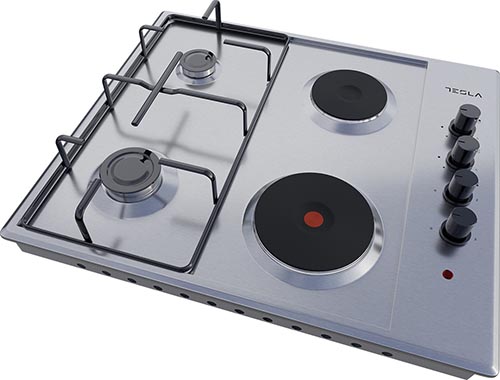
I used to live in Bosnia. Not only are power outages fairly common, but the country went through a miserable war and siege in the 90s.
So, many people have these stove cooktops, which are half electric and half gas: this way, they can cook regardless of whether there is a gas or electric outage (if both happen, well…then they are out of luck).
Combination cookers aren’t as popular in the United States and other Western countries, but you can still find them. If you live somewhere with frequent power outages, though, this might be worth considering.
10. Wood Stove
With a wood stove, you can both heat your home and cook during power outages. The obvious downside is that you’ll need to do some serious planning if you want a wood stove.
You need to install a flue, make sure it is regularly cleaned, and have a wood supply on hand.
The good news is that wood stoves produce a pleasant heat, and you will get in shape from chopping up all that wood. Please don’t use a portable wood stove indoors without proper venting, a door that seals shut, and a carbon monoxide detector!
11. Portable Power Stations
Unlike generators, portable power stations can be safely used indoors. They don’t use gas or diesel. Instead, you pre-charge the battery by plugging it into a wall outlet. Or you can charge them with solar panels.
Unfortunately, most portable power stations are expensive. They usually aren’t designed to power high-power appliances like electric hotplates either.
However, some portable power stations are large enough for cooking. If you can afford it and some solar panels, these are great all-around solutions for power outage preparedness.
Recommended: See our guide to the best portable power stations
Cooking without Power Outdoors
12. BBQ Grill
Your BBQ grill is a decent option for cooking during power outages, but only if you cook outdoors. Why? Because BBQ grills – especially charcoal grills – emit huge amounts of carbon monoxide. Never use one indoors. Don’t even use one in a semi-enclosed place like a garage or patio.
13. Open Fire
Cooking on an open fire can be a lot of fun. Unfortunately, it isn’t that easy to cook on a fire.
For starters, you’ll need to have a lot of wood. Ideally, you let the wood burn down to coals and cook over those. It takes a lot of skill to cook on an open flame since the flame blows around and varies in height.
Don’t be surprised if your pot of rice burns to the bottom.
The next issue with open-fire cooking is where you will put your pot or pan. The easiest option is to use a BBQ grill rack. If you don’t have one, you can create a stand-out of sticks over the fire. Then hang a pot from the stand.
Recommended: texsport Heavy Duty Camp Grill
14. Ember Roasting
Make a fire and get some serious embers going on. Then let the fire burn out (or keep the fire to one side of your pit only). Put some food on the embers. Go ahead and bury it in the embers. The embers will cook the food.
Since the outside of the food will get covered with ash, this method is best for foods like corn on the cob and potatoes. But you can cook almost anything like this if you put it in tinfoil first.
15. Solar Cooking
A solar cooker is a box that captures heat from the sun and uses it to cook food inside of it. Here are instructions on how to make your own solar cooker. You can also buy solar ovens, which do a good job of intensifying the sun with shiny surfaces.
Recommended: GoSun Go Portable Solar Cooker
16. Portable Wood Stove
Many modern portable wood stoves have clever designs that trap heat and make an intense flame without much wood. The pot stand is built into the design, so they are easier to cook with than on an open fire.
There is even one that converts the energy from the fire into power for charging your USB devices.
Recommended: BioLite Electricity-Generating Wood Stove
17. Hobo Stove
If you don’t want to buy a portable wood stove, you can make your own “hobo stove.” It’s a very basic and straightforward stove made from tin cans and fueled by sticks, twigs, etc. While not the most efficient cooker, this design can be made from supplies that most people have to hand.
The basic design can also be modified; see this post for more hobo stove plans.
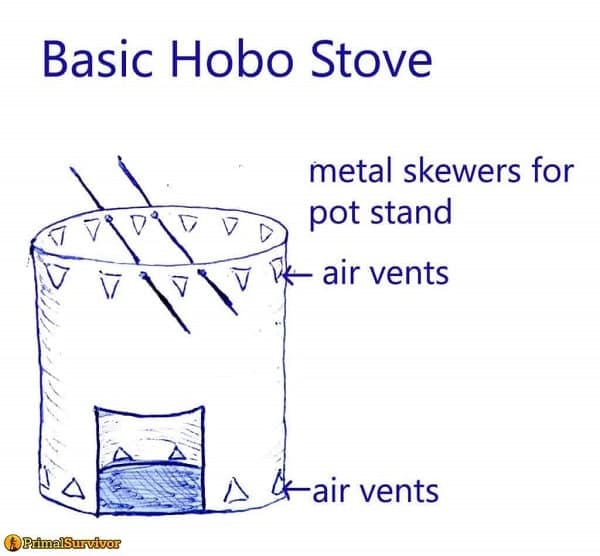
18. Dutch Oven
Dutch ovens are big, heavy cooking pots made from cast iron. You set them right on top of the fire and/or cover them up with coals. These are especially great for making stews.
19. Earth Oven
In simple terms, an earth oven is just a pit with a fire built inside of it. But there are a lot of different ways to make an earth oven.
Native Americans used a cool method where they’d dig a pit, put hot stones at the bottom, and then cover it with branches. On top of this would go the meat and veggies. It would be covered by something moist, which would create steam. Then would come a layer of soil to retain the heat.
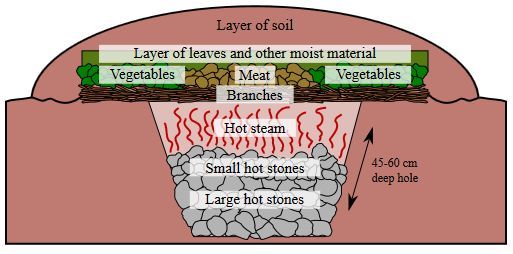
20. Reflector Oven
A reflector oven is a box with metal inside of it. There is a shelf in the middle for supporting the food. It works by using radiant energy from the campfire to bake food inside of it. You will need to make a big fire to bake in a reflector oven, and the heat source will need to be consistent.
21. Wick Stove
Wick stoves consist of a holding tank where you put fuel (usually kerosene, but they also burn diesel and lamp oil). The wicks draw the kerosene upwards towards a platform for holding a pot. These stoves are widespread in parts of the developing world, and you can sometimes find them in antique stores.
The issue with wick stoves is that they use dirty fuels which don’t burn completely. Never use one of these indoors: CO poisoning is a genuine risk! However, because kerosene is so cheap and they also work with diesel, it is a good backup emergency stove to have around.
22. Hexamine Tablets
Better known as Esbit, hexamine tablets are small and have a forever shelf life. A single tablet burns for about 15 minutes and will boil a liter of water in about 8 minutes. They supposedly are non-toxic and leave no ash.
However, there is a lot of debate about how many harmful chemicals they release into the air — thus, these are not something that you should ever use indoors. Also, note that esbit tablets will leave a nasty residue on your cooking pots.
How do you plan on cooking when the grid goes down? Get the conversation going in the comments area below!
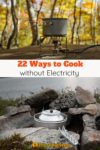




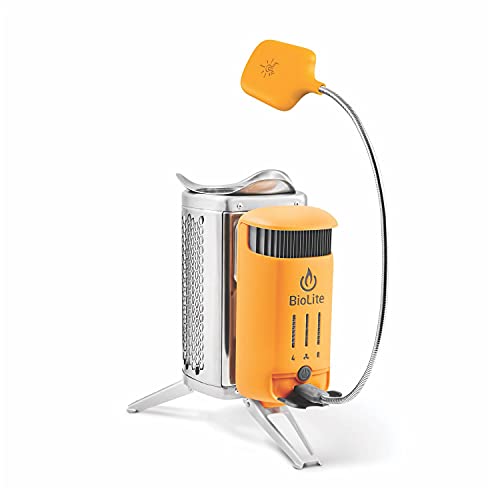


An OLD technique from the days when the northern cabin needed to shut down for frigid winters: close water access valves so no more water enters system. Open drain valves. No water in pipes to freeze anymore. Then put antifreeze down the drains to keep sink traps from freezing with residual water inside. In spring, drains open, turn on intake water to flush out antifreeze. When totally clear, close drain valve & let system refill, reversing the draining steps. Good to go. However you MUST not put antifreeze anywhere near water intake, its poisonous to drink. Dont let pets drink drained antifreeze its painfully fatal to them. Not pretty
For a long stretch without power (2+ years) or solar/wind (no water, no toilets, no shopping, no driving), what can you do to keep pipes from freezing? Leave the faucets open slightly?? And what’s a good toilet or wash system?
I’ve made and cooked on all kinds of rocket stoves. The simplest ones are just two cinder blocks and grates from an old, discarded gas stove top. You can make rocket stoves out of any kind of bricks or even rocks really. Lot cheaper and these cook with just twigs!
The Duke Says: I have been in Emergency Preparedness for over 40 years and I have noticed that people who are only occasional campers, have a very limited base of knowledge, particularly when it comes to cooking over a fire. Most of our preparedness training here in Houston revolves around dealing with hurricanes. One safety issue I always include, is to make sure that they know not to try to cook over treated wood, particularly meat. Unfortunately there is always someone who is unaware of this risk and there is always some family that gets sick. With all of the debris available, they scavenge the debris and use it as firewood and children especially have a tendency to stand in the smoke to get warm and inhale the pollutants. The Duke of Texas
Very good advice (thanks)! I unfortunately see that all the time when traveling to undeveloped countries. The people scavage wood and use it for heating and cooking. It smells disgusting and the poor people (literally and figuratively) are inhaling and consumign all those fumes. 🙁
Using a hydrocarbon fuel camp stove (butane, propane, etc.) indoors is NOT recommended by the manufacturers and can be highly dangerous because these fuels always emit carbon monoxide as they burn. Carbon monoxide is odorless and tasteless but can kill quickly. If you want to use one of these stoves you should have the following nearby:
– fire extinguisher (butane etc are highly flammable and the flames spread fast. Never use water to put out one of these fires!)
– battery powered carbon monoxide detector – NOT one that plugs in to the wall.
These stoves should only be used in a well ventilated area, near a window if possible. Remember they are intended to be used outdoors.
In any case, while using open flames including candles or tealights indoors for cooking, you should always have a fire extinguisher handy.
I have used a kerosene wick stove to practice cooking in the enclosed back porch. Need to use a wind screen for outdoor to use. A gallon of kerosene will last a long time if I’m going to need it to just cook/heat. I have an assortment of cast iron cookware so no worries there. Also have the oven from St. Paul Merchantile but need to start practice using it…LOL. Nice article.
We frequently practice cooking without power or gas (we use a gas stove). My children know how to cook over open fire and we frequently use a very simple grill, as well.
I bang on about it a lot but practice and drills are essential and often overlooked.
I bought a single hot plate that runs on butane and/or small bottle s of propane. I live in apartment and have experienced loss of power a few times. Works great. Look on amazon, read reviews before purchasing.
I spend at least one long weekend each month cooking on a camp stove, with a Dutch oven wrapped in an insulated blanket, and on the outdoor grill when we are at our other house. We have been remodeling the kitchen for the past year since we can only work on it over the long weekends that we have off. It is 700 miles away so our time is limited. (We also have a portable potty set up so when we get to the bathroom we will be covered.)
When you already have everything in place it makes it sooo much easier to deal with problems.
Thanks Nola, running practice drills is essential. Sounds like you’ve got this covered.